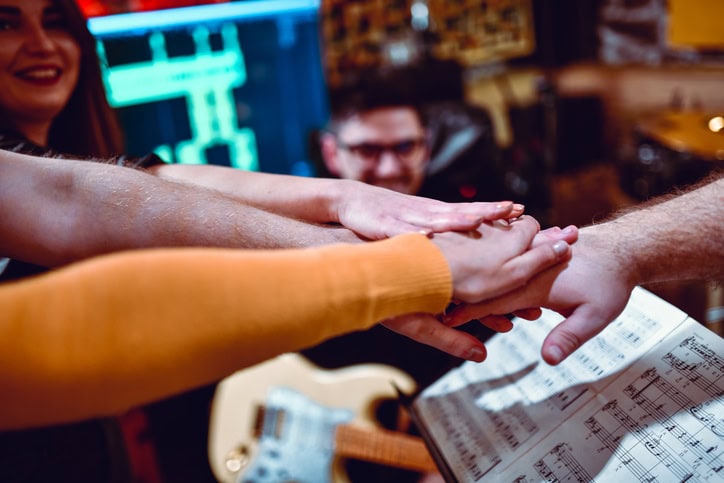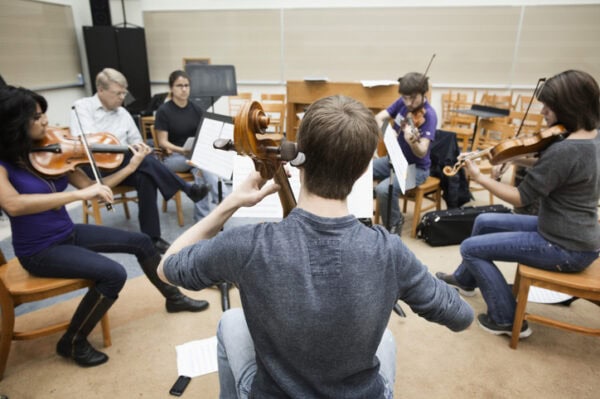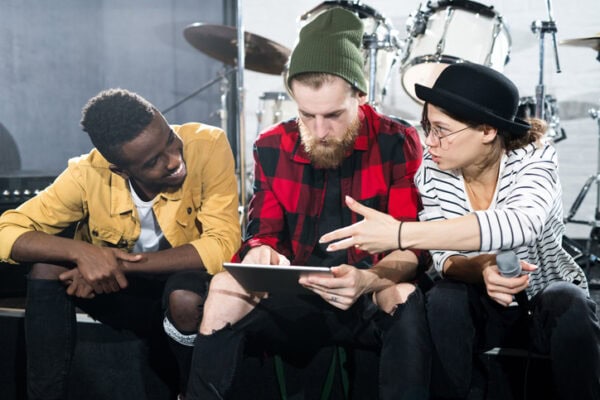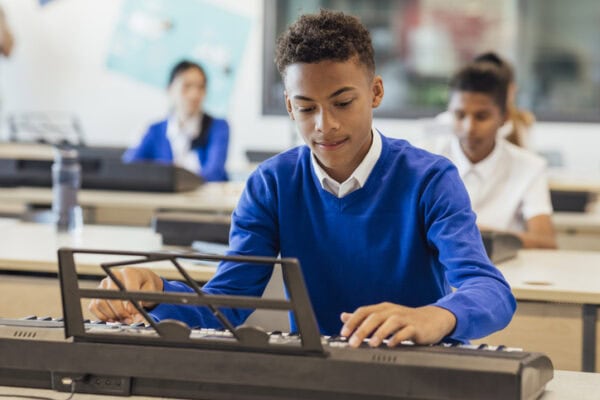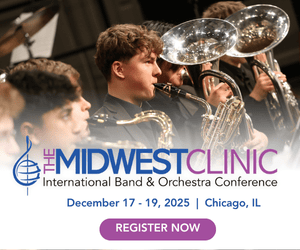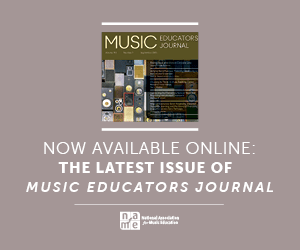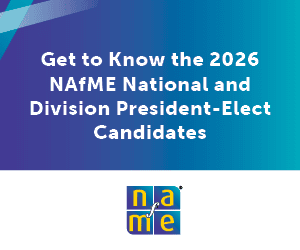/ News Posts / Building Bridges in Music Education
Building Bridges in Music Education
Pedagogy with Breath
By NAfME Members Dr. José Leonardo Leon, D.M.A. and Dr. José Valentino Ruiz
In the rhythms of our classrooms and rehearsal spaces, a question pulses beneath every lesson plan and concert preparation: What are we really teaching our students to become? More than just musicians or technicians, we are forming people who will either become cultural bridges or isolated echoes. In the age of hyper-connectivity, noise, and performance metrics, it has never been more vital to anchor our educational approaches in the transformative power of inspiration.
This is not about feel-good slogans. It’s about pedagogy with breath—and the ability to instill life-giving meaning into how students learn, grow, and relate to music.
Teaching beyond Technique: The Spirit of Inspiration
The word inspiration comes from the Latin inspirare, meaning “to breathe into.” For music educators, this is more than etymology. It is a call to infuse vitality into our teaching. When we inspire, we awaken something dormant in our students. When we ourselves are inspired, we teach not just concepts—but convictions.
At the heart of this concept is the idea of spirit—not in a vague or mystical sense, but as a practical fusion of three qualities: power, love, and sound mind. In a music education context, power refers to activating students to create, take risks, and perform with boldness. Love reflects relational pedagogy that cultivates empathy, inclusion, and connection among students. And sound mind represents the development of critical thinking, informed listening, and musical discernment.
When our teaching is guided by these three principles, inspiration is no longer a byproduct—it becomes the central current of the classroom. And without this current, music education risks becoming mechanical and impersonal. But with it, learning transforms into a deeply human, artistic, and purposeful experience.
From Exposure to Empowerment: Tangible Inspiration in Practice
Students cannot become whom they do not see or hear. One of the most underutilized pedagogical tools is exposure—giving students encounters with excellence that inspire aspiration. A story from a recent teaching session captures this truth. A student who was initially disinterested in the trombone was later transformed by hearing recordings of Canadian Brass and Empire Brass. It wasn’t a syllabus that changed his mind—it was sound that stirred the soul.
Educators must therefore curate experiences that go beyond repertoire. We should intentionally introduce students to transformative performances, living musicians, and culturally meaningful moments that breathe life into the instrument. Playing compelling recordings during class, inviting guest artists, and even sharing behind-the-scenes videos where passion is visible can act as powerful stimuli. These aren’t tangents to the curriculum—they’re what we call instructional oxygen.
To build upon this, teachers can incorporate regular “Inspiration Sessions,” where students share music that emotionally moved them. These sessions help students articulate what inspires them and draw connections between those emotional moments and their performance or creative work. As students begin to align their artistry with their inner life, technical exercises gain new meaning and relevance.
Building Bridges in Music Education
Inspiration must be paired with direction. This is where the metaphor of the bridge becomes essential. A bridge spans a divide—it enables movement from one reality to another. Music educators are often the architects of these bridges, connecting students’ current limitations to future possibilities.
For some students, the divide is cultural—they have yet to encounter music that reflects their heritage. For others, the gap may be emotional or economic—barriers that stifle access to resources or opportunities. Still others may face artistic divides, unsure of how to move from technical proficiency to expressive depth. As teachers, we don’t eliminate these divides—we construct the path across them.
This can be done through cross-cultural collaborations, interdisciplinary units that merge music with storytelling or history, or by giving students opportunities to perform in new environments such as community centers, assisted-living facilities, or faith-based organizations. These real-world musical encounters become bridges of transformation.
A helpful classroom approach is the “Bridge Project,” where students choose an audience they don’t typically interact with and design a musical gesture or event specifically to connect with them. Whether it’s composing for a local nonprofit, organizing a benefit concert, or recording educational content for under-resourced schools, these projects empower students to use their music as a tool for connection. Post-project reflections help students internalize the significance of their outreach and understand music’s power beyond performance.
Teaching Identity First, Skill Second
Much of traditional music education revolves around tasks: scales, auditions, juries, ensemble parts. But few programs start by asking, Who are you becoming through your music? This question is foundational because identity is the soil from which purpose grows. Without clarity about their identity, students may achieve technical success but lack artistic voice.
This doesn’t suggest we forsake technical rigor—it means we frame it differently. We teach skill not as an end in itself, but as a tool of expressive authenticity. One effective method is the “Artist Statement” assignment at the start of a semester, where students reflect on their influences, values, and hopes for their music. This statement becomes a reference point for ongoing evaluation—not just of what students do, but of who they are becoming.
By grounding our instruction in identity formation, we also help students bring their cultural backgrounds, faith traditions, and personal stories into their artistry. This creates a more inclusive classroom culture and equips students with the self-awareness to navigate their careers with integrity. It also guards against comparison and burnout, reminding them that their worth as musicians is not measured by applause but by authenticity.
Inspiration as a Currency in Music Education
In the world of arts entrepreneurship, there is a tendency to equate value with revenue. But within educational contexts, it’s worth remembering that inspiration is its own currency—and it circulates in the form of trust, motivation, and artistic vision.
What inspires a student often shapes their trajectory. Educators, then, are not just instructors; we are curators of formative experiences that shape imagination. This applies not only in performance or composition classes, but especially in methods and pedagogy courses.
In higher education settings, entrepreneurship should be framed as bridge-building, not just profit-making. This means exposing students to real-world examples of musicians who use their artistry for community transformation—whether through nonprofit work, educational startups, recording collectives, or intercultural festivals. These models show students that sustainability in music is not merely about making a living—it’s about making a difference.
When Plans Fail: Inspiration as the Fuel for Adaptability
A final and timely point: inspiration becomes essential when plans fall apart. Every music teacher knows the pain of canceled concerts, budget cuts, or sudden shifts to virtual learning. For students, these moments can trigger disillusionment. But students rooted in inspiration don’t collapse under the weight of uncertainty—they pivot. Why? Because their why is stronger than their what.
In our digital age, remote learning has made this particularly relevant. During hybrid semesters, some teachers have introduced the idea of “Resilience Reels”—short videos or essays where students share how they overcame a musical challenge. These narratives build classroom solidarity and help students reframe adversity as a stepping stone, not a setback.
As educators, our response to disruption must model inspired adaptation. We can turn canceled concerts into recording opportunities, convert competitions into collaborative projects, and use downtime for deep listening and reflection. Every obstacle becomes a classroom if we carry the breath of inspiration into it.
Breathing Life into the Next Generation
As music educators, we stand at a profound intersection. We are shaping not only the skillsets of future musicians, but the spirit in which they will use those skills. The classroom is not just a space for learning notes—it is a space for learning meaning.
Let us remember: We are not merely teaching repertoire. We are awakening purpose. May our instruction not just reinforce accuracy, but cultivate conviction. May our classrooms not just be productive, but profoundly inspirational. And may our students look back, years from now, and say of us—not just that we taught them—but that we breathed life into their music.
Because where there is a bridge, there is access.
Where there is access, there is opportunity.
Where there is opportunity, there is transformation.
And where there is transformation—there was a teacher who first exhaled purpose into the room.
About the authors:
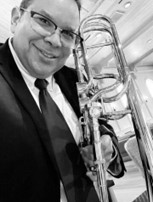 NAfME member Dr. José Leonardo Leon, D.M.A. is a music educator, trombonist, and program director of the Arts & Performance Entrepreneurship Initiative at Florida Atlantic University. He specializes in creative curriculum design, applied improvisation, and multicultural engagement in music education. Dr. Leon has presented nationally on topics related to identity-driven pedagogy and innovative ensemble leadership. His work emphasizes empowering students to become culturally responsive artists and community builders. For more information, visit: www.joseleonardoleon.com.
NAfME member Dr. José Leonardo Leon, D.M.A. is a music educator, trombonist, and program director of the Arts & Performance Entrepreneurship Initiative at Florida Atlantic University. He specializes in creative curriculum design, applied improvisation, and multicultural engagement in music education. Dr. Leon has presented nationally on topics related to identity-driven pedagogy and innovative ensemble leadership. His work emphasizes empowering students to become culturally responsive artists and community builders. For more information, visit: www.joseleonardoleon.com.
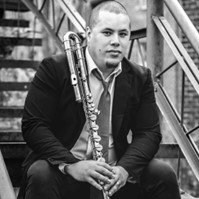 NAfME member Dr. José Valentino Ruiz is an Emmy® Award-winning musician, educator, and program director & associate professor of Music Business and Entrepreneurship at the University of Florida. As a four-time Latin GRAMMY® Award recipient, Global Genius® Grand Prize Winner, two-time IADAS Anthem® Award Winner for Best Strategy in Education, Art, and Culture, and 55-time DownBeat® Award winner, he bridges artistry with entrepreneurship to mentor the next generation of artist-leaders. Dr. Ruiz is the founding editor of Creativity & Commerce Journal. His scholarship explores the intersection of identity, inspiration, and vocational impact in the arts. For more information, visit: www.josevalentino.com.
NAfME member Dr. José Valentino Ruiz is an Emmy® Award-winning musician, educator, and program director & associate professor of Music Business and Entrepreneurship at the University of Florida. As a four-time Latin GRAMMY® Award recipient, Global Genius® Grand Prize Winner, two-time IADAS Anthem® Award Winner for Best Strategy in Education, Art, and Culture, and 55-time DownBeat® Award winner, he bridges artistry with entrepreneurship to mentor the next generation of artist-leaders. Dr. Ruiz is the founding editor of Creativity & Commerce Journal. His scholarship explores the intersection of identity, inspiration, and vocational impact in the arts. For more information, visit: www.josevalentino.com.
Interested in reprinting this article? Please review the reprint guidelines.
The National Association for Music Education (NAfME) provides a number of forums for the sharing of information and opinion, including blogs and postings on our website, articles and columns in our magazines and journals, and postings to our Amplify member portal. Unless specifically noted, the views expressed in these media do not necessarily represent the policy or views of the Association, its officers, or its employees.
Published Date
May 8, 2025
Category
- Program Development
- Representation
- Social Emotional Learning
Copyright
May 8, 2025. © National Association for Music Education (NAfME.org)
